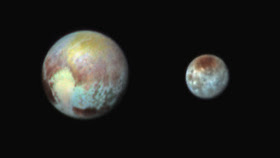My two favorite field geologic tools are my Brunton Compass:
and my Estwing rock hammer:
[It did look like this when it was new:]
And now it looks like this (rock hammer, Brunton, and Brunton case):
The Brunton compass is used primarily to take the strike and dip of rocks in an outcrop as described in this three-minute video.
The Brunton compass (actually the Brunton Pocket Transit) is a precision compass made by Brunton, Inc. of Riverton, Wyoming. The instrument was patented in 1894 by a Canadian-born Colorado geologist, David W. Brunton.
Unlike most modern compasses, the Brunton Pocket Transit utilizes magnetic induction damping rather than fluid to damp needle oscillation.
From the Wikipedia article on the Brunton Compass:
"With the advent of portable electronic devices a new generation of compasses has emerged, some again of specific interest to geologists. Unlike analogue compasses, a digital compass relies on an accelerometer and a teslameter, and may provide much information as to the reliability of a measurement (e.g. by repeating the same measurement and performing statistical analysis). Programmers of today's smartphones have responded with different geological compass apps. However, caution must be exercised: Because the Earth's magnetic field fluctuates rapidly, 'smartphone' 3 axis magnetometers can potentially measure noise. Furthermore, all smartphones create strong magnetic fields that must be corrected by computer algorithms. At present, all geological compass apps should be tested against traditional magnetic compass measurements."
My trusty Brunton was also used for siting along with a plane table and alidade in barite mapping in Mexico. Here's a photo of Francisco who was my bodyguard and occasional rod man
while I tromped around on the rocks, measuring strike and dip, sampling thick barite beds, and dropping acid
(a mixture of Alizarin red S and potassium ferricyanide dissolved in a dilute hydrochloric acid solution)
on rocks to determine if the carbonate was calcite (bright red or pink) or dolomite (white, brownish-grayish-greenish or clear).
I used my Brunton to measure the strike of metamorphic features in addition to sedimentary layers. The Brunton is still used by geologists, archeologists, and other scientists (though the price is now between $350-$700; I bought mine used for $75 and that was a really good deal.)
My rock hammer has pounded on rocks from Spain to Mexico to all over the U.S. Field geology is a truly a blast!
Two of my other favorite "tools?" A tractor and a backhoe used to dig trenches to get a better look at the thick barite beds beneath the surface in Cobachi, Sonora, Mexico.
What's your most trusted tool?
Steph
































